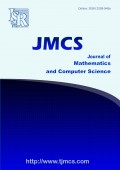Computational Model of Social Intelligence Based on Emotional Learning in the Amygdala
-
3272
Downloads
-
5839
Views
Authors
Alireza Falahiazar
- Computer Department of Islamic Azad University Science and Research Branch, Tehran, Iran
Saeed Setayeshi
- Faculty of Nuclear Engineering and Physics, Amirkabir University, Tehran, Iran
Yousef Sharafi
- Computer Department of Islamic Azad University Science and Research Branch, Tehran, Iran
Abstract
Today, neural systems are being applied as a powerful tool to solve a host of problems. The more computational model of the presented neural system and the neural system of animals look alike, the more powerful the computational model would be. The brain emotional learning algorithm in the Amygdala inspired by Limbic of mammalian brains was put forward originally by Mor´en. A combination of some Limbic systems as some living creatures will be applied in this paper. The gathering of these living creatures and output summation of each Limbic system in accordance with the relevant applied coefficient will result in social intelligence. The proposed model has been compared with feed-forward back propagation network, Elman back propagation network, and a computational model of emotional learning in the Amygdala to forecast Mackey-Glass Chaotic Time Series. The results of the above mentioned comparison concludes that in forecasting Mackey-Glass Chaotic Time Series, the computational model of social intelligence based on the emotional learning in the Amygdala has shown fewer errors in not only training patterns but also testing patterns.
Share and Cite
ISRP Style
Alireza Falahiazar, Saeed Setayeshi, Yousef Sharafi, Computational Model of Social Intelligence Based on Emotional Learning in the Amygdala, Journal of Mathematics and Computer Science, 14 (2015), no. 1, 77-86
AMA Style
Falahiazar Alireza, Setayeshi Saeed, Sharafi Yousef, Computational Model of Social Intelligence Based on Emotional Learning in the Amygdala. J Math Comput SCI-JM. (2015); 14(1):77-86
Chicago/Turabian Style
Falahiazar, Alireza, Setayeshi, Saeed, Sharafi, Yousef. "Computational Model of Social Intelligence Based on Emotional Learning in the Amygdala." Journal of Mathematics and Computer Science, 14, no. 1 (2015): 77-86
Keywords
- Machine Intelligence
- Social Intelligence
- Emotional Learning in the Amygdala
- Mackey-Glass Chaotic Time Series
MSC
References
-
[1]
McCulloch Warren, Walter Pitts, A Logical Calculus of Ideas Immanent in Nervous Activity, Bulletin of Mathematical Biophysics, 5 (4) (1943), 115–133.
-
[2]
F. Rosenblatt, The Perceptron: A Probalistic Model for Information Storage and Organization In The Brain, Psychological Review , 65 (6) (1958), 386–408.
-
[3]
B. Widrow, S. D. Stearns, Adaptive signal processing, Englewood Cliffs, NJ: Prentice Hall (1985)
-
[4]
M. Minsky, S. Papert, An Introduction to Computational Geometry, MIT Press, (1969)
-
[5]
S. Grossberg, Classical and instrumental learning by neural networks, Progress in Theoretical Biology, 3 (1974), 51-141.
-
[6]
G. A. Carpenter, S. Grossberg, The ART of adaptive pattern recognition by a self-organizing neural network, IEEE Transactions on Computers , 21 (3) (1988), 77–88.
-
[7]
J. A. Anderson, E. Rosenfeld (Eds.), Neurocomputing: Foundations of Research, Cambridge, MA: MIT Press. Referred to as NFR. [Out of print, available in CompNet Library], (1988),
-
[8]
J. A. Anderson, S. Lehmkuhle (Eds.), Synaptic modification, neuron selectivity, and nervous system organization , Hillsdale, NJ: Erlbaum , (1985),
-
[9]
J. R. Anderson, Methodologies for studying human knowledge, Behavioral and Brain Sciences, 10 (1987), 467-505.
-
[10]
T. Kohonen, E. Oja, O. Simula, A. Visa, J. Kangas, Engineering application of the self-organizing map, Proceedings of the IEEE , 84 (10) (1996), 1358–1384.
-
[11]
T. Kohonen, Self-Organizing Maps, Springer, New York (1995)
-
[12]
P. J. Werbos, Beyond Regression: New Tools for Prediction and Analysis in the Behavioral Sciences, , (1975)
-
[13]
A. Ghezelbash, Predicting Changes in Stock Index and Gold Prices to Neural Network Approach, The Journal of Mathematics and Computer Science, 4(2) (2012), 227-236.
-
[14]
M. Bagheri, M. Valipour, V. Amin, The Bankruptcy Prediction in Tehran share holding using Neural Network and it’s Comparison with Logistic Regression, The Journal of Mathematics and Computer Science, 5(3) (2012), 219-228.
-
[15]
M. M. Javidi, M. H. Nattaj, A New and Quick Method to Detect DoS Attacks by Neural Networks, The Journal of mathematics and computer Science, 6 (2013), 85-96.
-
[16]
Z. Falahiazar, M. Rohani, A. Falahiazar , Controlling the False Alarm in an Intrusion Tolerant Database System Using Significance Degrees of Data Objects, Journal of mathematics and computer science, 13 (2014), 212-225.
-
[17]
Martin T. Hagan, Mohammad B. Menhaj, Training feedforward networks with the Marquardt algorithm, Neural Networks, IEEE Transactions on , 5(6) (1994), 989-993.
-
[18]
L. Falahiazar, M. Teshnehlab, A. Falahiazar, Parallel Genetic Algorithm Based on a New, in International Conference on Recent Advances in Computing and Software Systems, (2012)
-
[19]
Y. Sharafi, M. Ahmadieh Khanesar, M. Teshnehlab, Discrete Binary Cat Swarm Optimization Algorithm, in Computer, Control & Communication (IC4), 2013 3rd International Conference on, (2013)
-
[20]
J. Moren, C. Balkenius, A computational model of emotional learning in the amygdala, From animals to animats, 6 (2000), 383-391.
-
[21]
J. Moren, Emotion and learning a computational model of the Amygdala, Lund University, Vol. 93 (2002)
-
[22]
J. Friedenberg, G. Silverman, Cognitive science: an introduction to the study of mind, Sage. , (2011)
-
[23]
S. Zeki, The neurobiology of love, in FEBS Lett. PMID 17531984., 581 (2007), 2575-2579.
-
[24]
M. T. Hagan, H. B. Demuth, M. H. Beale, Neural network design, Boston: Pws , Vol. 1 (1996)
-
[25]
J. Elman, Finding structure in time, Cognitive Science, 14 (1990), 179 -211.
-
[26]
M. C. Mackey, L. Glass , Science, , 197 (1977), 287–289.

